In winter, we face the Milky Way's anticenter, a little-explored region offering goodies for telescopes both large and small.
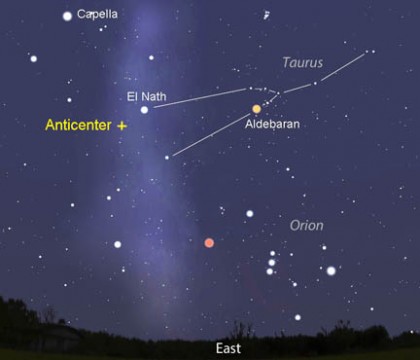
Source: Stellarium
Few give much thought to the Milky Way's anticenter, a lonely locale 180° opposite the busy metropolis of Sagittarius, where the summer Milky Way glitters like Vegas.
On winter nights, Sagittarius lies behind us, hidden by Earth's bulk. Step outside around 8:30 p.m. in early January, direct your gaze at Taurus, and you’ll quickly find yourself in the Milky Way’s countryside. The bright lights and busy intersections of the galactic metropolis lie far behind. Ahead, the Milky Way appears thin, anemic. But not empty. Like a small town with a single general store that has one of everything, you won't go home disappointed after poking around here with your telescope.
The Milky Way's anticenter lies near the star Beta (β) Tauri (Elnath), a star shared by Taurus and Auriga. When we look toward the anticenter, our gaze first penetrates the narrow spiral arm called the Orion Spur where our solar system and many of the nighttime stars call home. Approximately 6,000 light-years out, we encounter the Perseus Arm of the Milky Way, the next spiral arm outward from the galactic center and home to the famous Double Cluster in Perseus.
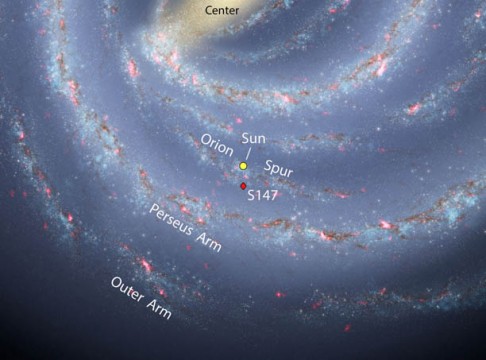
ESO, with additions by author
Our eyes have the wonderful ability to travel vast distances effortlessly, so let's keep going. At 15,000 light-years from home, we reach the Outer Arm. From there to the edge of the galactic disk, stars thin out and nebulae dwindle until at 30,000 light-years, we stand on the precipice of intergalactic emptiness.
Let's pull in a bit, though, and explore in the direction of the anticenter but relatively close to home. We'll begin at 2nd-magnitude Elnath. From here, glide 3° northeast to 26 Aurigae, an attractive, unequal double star for any telescope. The 8th-magnitude companion lies 12″ nearly due west of the yellowish 5.5-magnitude primary, making for neat pair at low power.
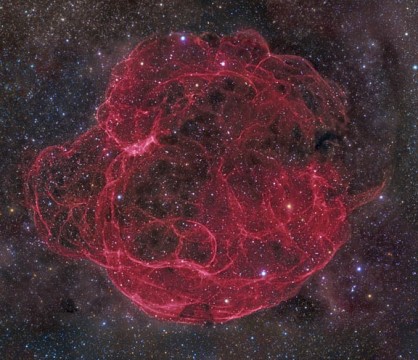
Rogelio Bernal Andreo
From 26 Aur, we leap into the deep. You can either print out a copy of the black-and-white map below or use the annotated photo to star-hop from one cluster and nebula to the next here at the Milky Way's antipode. The showpiece deep-sky object, Simeis 147, a spectacular supernova remnant, looks magnificent in photographs, but its faintness will tax your observing skills. I suggest "warming up" with some of the brighter objects first, then tackling the remnant when your confidence is high and night vision off the charts.
From 26 Aur, star-step 2° east and slightly south to the open cluster Basel 4, a small, 5′-diameter, 9th-magnitude star cluster shaped like a taut bow facing west. Its brightest stars are about magnitude 11.5. I saw 25 to 30 in my 15-inch (37-cm) reflector at 142× and would call it distinctive but not rich. I was surprised to learn the cluster data lists 134 stars. How many do you see?
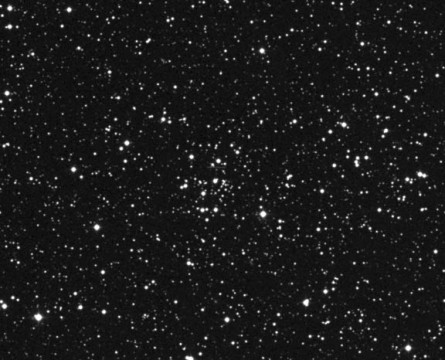
NASA / ESA
From here, drop 1.5° south-southeast to Czernik 23, a round, little-concentrated open cluster about 5′ across. Using 142x, I counted at least 50 stars of magnitude 13 or fainter. At first glance, only a few stars pop into view, but with medium magnification and averted vision, many more surface from the depths. Respect your elders — the cluster is one of the oldest in the galaxy with an approximate age of 5 billion years.
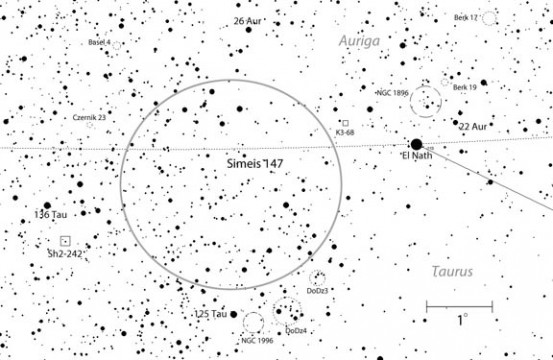
Chris Marriott's SkyMap
A little more than 4° southwest of Czernik 23, we arrive at a trio of open clusters. One, NGC 1996, is listed as a possible cluster; it might just be a random, richer-than-normal bunching of unrelated Milky Way stars. I see a rich but little-concentrated "ball" of 40-50 fainter stars immediately southwest of 5th-magnitude 125 Tauri. I can almost squeeze NGC 1996 and the two tongue-twisting Dolidze Dzimselejsvili (DoDz) open clusters into my 1° field of view.
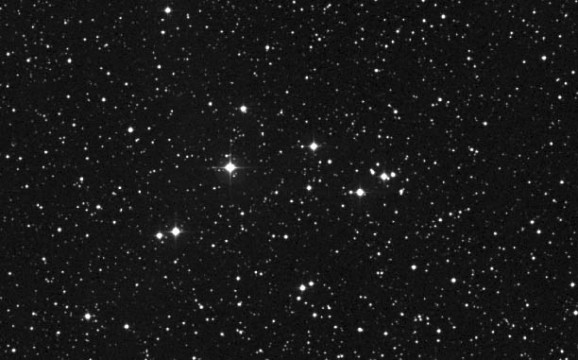
NASA / ESA
Most of the DoDz clusters are loose and star-poor, but often bright and easy to spot in small- and medium-sized scopes. These were no exception. DoDz 4 tallies some 25 stars between magnitudes 6.5 and ~11, making it an easy target. Next-door neighbor DoDz 3 has only 10 stars, but it's shaped like a cursive "V", so it really stands out, even at low power. The star at the western tip of the "V" appeared triple; that at the eastern end, double.
Heading north, we cross paths with the faint planetary nebula Kohoutek 3-68, labeled as P178.3-2.5 in the Uranometria atlas and located 1° northeast of Elnath. Listed at 16th magnitude, I assumed it would be invisible in my 15-inch, but I was wrong. A faint, glowing blob 10″ across 1′ north-northeast of an 11th-magnitude star revealed itself at 142x and 257x without an O III filter. Apparently the nebula has a high surface brightness despite its faint magnitude listing. Still a difficult object requiring averted vision. I applied an O III filter and noticed a slight enhancement in brightness, but not nearly to the degree typical in most planetaries.
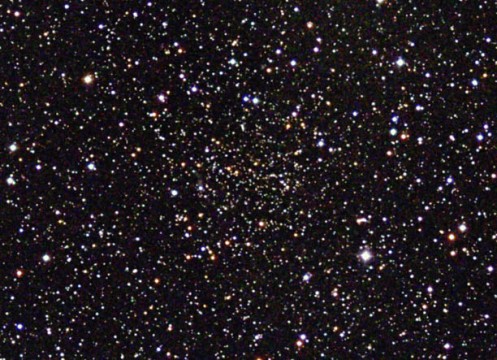
Michael Stecker
Next, we return to Elnath (Beta Tau). To its northwest by 40′, another possible open cluster beckons, NGC 1896. This bright, easy, and loose group boasts a beautiful red star, the cluster's brightest member at magnitude 8.5. Don't miss it.
I always enjoy hunting for Berkeley star clusters. While many are faint, they're often quite rich: I love the sense of depth one gets looking at tiny stars scintillating against a luminous background haze of unresolved stars. You'll find Berkeley 19, a faint patch of milky haze about 2′ across some 15′ northwest of NGC 1896. I see only a handful of stars resolved at 142×, but Star Clusters by Archinal and Hynes, lists Berk 19 as having 150 stars jammed into a 4′ space. The overall cluster magnitude is 11.4, but its brightest stars glimmer dimly at magnitude 15.
The final cluster, Berkeley 17, located northwest of Berk 19, resolves into a gorgeous mass of faint stars, with the brightest around 13.7, using 142×. Misty, distant, lovely . . . and ancient! It's the oldest known open cluster in the Milky Way galaxy with an age of 8.5–9 billion years. That's an incredible amount of time for an open cluster to hang together without its members straying.
The only object I couldn't see in my anticenter sweep was the faint emission nebula Sharpless 2-242. Despite its bright appearance in photographs, no amount of telescope tapping could convince me it was there. Perhaps you'll have better luck.
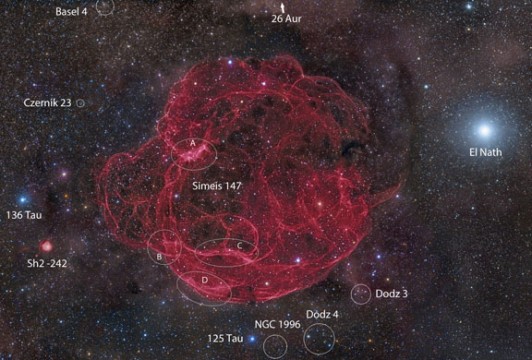
Rogelio Bernal Andreo
We return now to the supernova remnant Simeis 147 also known as Sharpless 2-240 or the Spaghetti Nebula. This big red rose with glowing petals of hydrogen gas is located very close to the anticenter direction, 3,000 light-years away. Measuring 150 light-years in true diameter, it spans some 3° as seen from Earth.
When the progenitor star went supernova approximately 40,000 years ago, the earliest modern humans were creating spectacular cave art and just beginning to learn the intricacies of language. Did they witness the event? What utterances did they use to describe the sight?
As their shock wave ripples across the light-years, remnants can blossom into enormous and intricate forms. I don't know anyone who's seen all of the Spaghetti Nebula, but it's possible to see the brighter parts with a 10-inch or larger telescope and O III filter. I was able to glimpse four sections in my 15-inch with an O III filter, which I've labeled A through D on the map. Here are my rough notes made at the telescope:
(A) Faint, diffuse patch centered on a small, box-shaped group of five stars. Also saw the spike or curl of nebulosity curving to the west and north of here.
(B) Another faint patch of haze, but the brightest and easiest part of the nebula for me.
(C) This tendril overlaps an east-west string of bright field stars. Tricky and faint, requiring rocking the scope back and forth to bring the nebula into view.
(D) Main east-west tendril visible.
The anticenter is home to a number of beautiful and even exceptional objects. I hope you'll make a visit there the next moonless night to gather up a few plums of your own.
 2
2
Comments
Aqua4U
January 10, 2016 at 8:45 pm
Now I'm just dying to get a clear night! Gemme see! I want another viewing of Comet Catalina and to look for some of the above. Eyeah... it's been +2 wks of nonstop gray and rain, making it ever so much more pleasurable to read your stuff.... Thanks.
Q: What would be the best filter to use possible viewing of Simeis 147? I can see the both sides of the Veil Nebula in Cygnus without filters... but wonder what I might be missing?
You must be logged in to post a comment.
Bob KingPost Author
January 12, 2016 at 1:31 am
Hi Aqua,
I wish you a clear sky soon! The best filter would be an OIII. This one's a lot fainter than the Veil. Good luck!
You must be logged in to post a comment.
You must be logged in to post a comment.